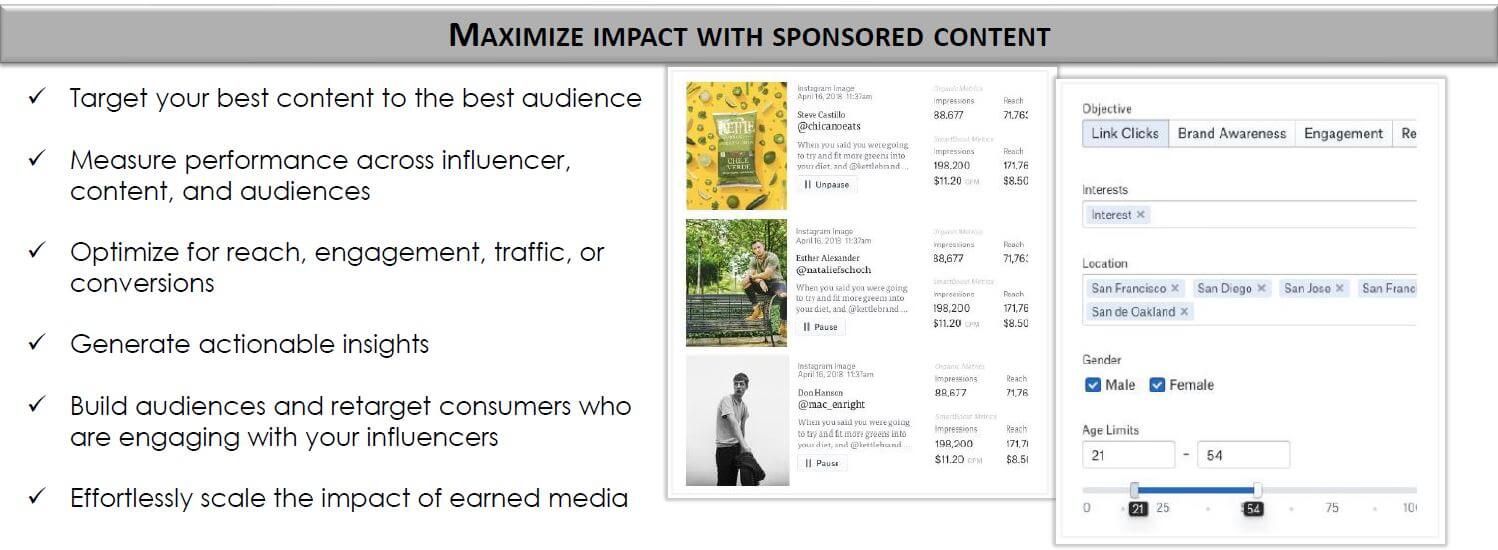Why Influencer and Content Marketing Work
In today’s digital space traditional ads are not given the same interactive and emotional response by the consumer. For example, are you more likely to buy a product after you’ve read an engaging post from a trusted source, or seeing a banner ad on a website?
For example, here is a common path to purchase sequence taken by online consumers…
- A consumer receives a recommendation about a product or service in a social media post or that piques their interest.
- They want to learn more, so they go to their favorite blog, social media platform to research. They actively engage with relevant quality content.
- They seek final clarification about features, pricing, availability and shipping details by going to the brand’s site or a retailer’s site.
- They purchase the product or service online or in-store.
This is one of the reasons why influencer marketing is dominating the marketing industry becoming more impactful than most forms of traditional advertising. Marketing through influencers provides a way for brands to work with someone who has established credibility in a specific niche and can persuade purchase decisions of their audiences because of their authority, knowledge, and relationship with their audiences on social media and on blogs.
But how does influencer marketing help brands reach and engage their targeted audience effectively at every stage of the new purchase journey?
1. It Delivers ROI for Marketers
When executed properly influencer marketing works and can deliver significant ROI for brand marketers.
Influencer marketing strategies should be designed with the same conversion attribution and marketing efficiencies in mind, whether brand marketers are focusing on increasing return, reducing investment, or some combination of the two. Brand marketers need to be able to quantify the full value of influencer marketing programs in the context of both incremental return: brand lift, sales lift, or channel lift, as well as, money saved by way of reduced investment: time savings, creative savings, media savings, content savings, and software savings.
Here are ways brand marketers can measure influencers creativity and return-on-investment:
Increase Return via Sales Lift
- Online Sales Lift: is regulated via conversion tags, pixels, promotional codes and app installs.
- Offline Sales Lift: is a study that looks at shopper data and compares results between an exposed cohort and a control group. It requires minimum exposure and the ability to tag the content and it’s best practice is to blackout other marketing activity.
Increase Return via Brand Lift
Implement a brand lift study by surveying an exposed cohort and control group with questions to collect responses around recall, net promoter score, sentiment, and intent. You can also work with influencers to poll their audience before and after exposure to your campaign.
Increase Return via Channel Lift
Repurpose or syndicate high-performing influencer content to improve the performance of existing e-commerce and other paid or owned channels, comparing performance to historical benchmarks.
Reduce Investment via Time Savings
Operational related costs add up quickly. Influencers enable you to scale or accelerate your existing content generation efforts without adding additional manpower.
Reduce Investment via Content and Production Savings
Most brands are paying creative agencies for content/asset generation to use for posts, images, videos, and reviews. With an integrated influencer marketing strategy, you can generate them all for less cost to create your library of branded marketing assets to use and repurpose in campaigns.
Reduce Investment via Software Savings
Having a suite of technologies available enables marketers to save costs by replacing tracking solutions, influencer identification as well as a centralized location to manage and report consumer data.
Here’s a snapshot of an infographic from Social Media Today on the ROI of influencer marketing, highlighting the fact that marketers generally see an 11X return on investment from the impact of influencer marketing on consumers compared to other types of traditional marketing.

2. Influencers Create Credible, Trustworthy Content
Influencers are real, and the best influencers are honest, know and respect their audience, and don’t lie about products. They can deliver real value for both brands and the audience of friends and followers they’ve accumulated over the years.
When trusted influencers promote your offerings, it shows their trust in you and lays the foundation for the creation of a brand, and when customers believe and resonate with your brand, they become loyal to your company and subsequently become influencers for your product or service by telling and promoting it to their friends and family.
3. Increase Branding and Awareness
One of the most crucial influencer marketing goals a brand should focus on is to increase their brand awareness. As discussed, people usually convert into your customers when they begin to recognize and see your brand being endorsed by trustworthy friends and family and those conversations will expand your reach and increase people’s awareness and ultimately your bottom line.
4. Ability to Leveraging Influencer Generated Content (IGC)
IGC is organically created and shared by your brand influencers, and when you collaborate with these influencers, they will come up with quality content assets for your brand at a fraction of the price of a creative agency.
IGC makes it possible to engage your audience in a more profound, more meaningful way, and that’s a connection that you should take advantage of. Research shows that roughly half of the surveyed marketers said that influencer content performed better than brand-produced content, typically in terms of generating positive engagement from brand customers.
Do you wonder why user-generated content builds a deeper emotional connection with your audience?
- It comes from sources that consumers trust and follow
- It comes across as authentic and original
- It provides your audience with a feeling of being a part of a community with shared interests
- It is usually more memorable and entertaining
5. Ability to Track and Report in Real Time.
One of the essential things in influencer marketing should be having the ability to track the success of their influencer marketing campaigns. However, this can be easier said than done.
Influencer marketing has a delayed effect, and too many influencer marketing campaigns are stuck using old tactics and only measuring reach and engagements. Modern influencer marketing requires real-time analysis of not just engagements but clicks and sign-ups as well from each piece of content across all social media platforms and blogs.
Here are examples of what metrics to measure ROI
- Direct sales: If you want to measure ROI of your influencer campaign by direct sales, give influencers a unique code to give to their audience that they can use at checkout for a percentage off their purchase. A good amount is 20%-30% off.
- Brand Lift: Showing a user multiple content by different influencers in one campaign significantly increases brand lift and purchase intent.
- Impressions and Reads: Ask influencers to share their review of your product on their blog and their social channels.
- Activations: If you’re trying to generate leads via your influencer marketing campaign, make sure you have a juicy piece of content that influencers can share with their audience.
- Engagement Rate: Indicates the performance of the influencer’s content. If you want consumers liking, commenting and sharing your content make sure your influencer posts are worth sharing. The various engagement metrics indicate the extent to which the audience is interacting with your brand and consuming the material put out by the influencer. Engagement can be measured by tracking metrics such as likes and reactions, comments, shares, and brand mentions.
- Clicks: Create unique URLs for individual influencers to find out the number of clicks driven by each influencer and to be able to determine post-click activity.
- Reach: Indicates the number of people who see your influencer’s content. The primary reason for brands to take to influencer marketing is the incredible reach offered by various social networking platforms.
- The number of posts: If you want influencers to produce content for a particular channel, supply high-quality visual and content assets that they can use (i.e., pictures of your brand’s product). Also, ask influencers to post across all of their channels to maximize the types of content that your brand receives.
- Earned Media Value: This is the ability to measure the cash value of social media campaigns, and it’s a more transparent way for companies to judge the value of their investment in influencer marketing.
Here are additional sales-related metrics as ways to measure influencer content effectiveness:
- Promotion code redemption
- Lift in online mentions
- Branded keyword search volume lift
- Correlated sales lift
- Ad recall lift rate
6. Ability to SmartBoost Your Content and Create Retargeting Audiences
Part of an effective influencer marketing strategy needs to include content amplification to combat low reach and content fatigue.
With paid media amplification, it becomes much easier to measure, scale, and even optimize your campaigns. You get high-quality content that feels native. In addition to this, you get to target the right audience and then measure the campaign results.
The best way to do this is to use a smart solution to tap into premium influencer-derived audiences, construct lookalike audiences, and run hyper-targeted social ads natively through influencer accounts all the while optimizing for brand awareness and media spend.
But how is this done? Through machine learning of course! Our technology identifies the best combination of content, influencers, and audiences and uses SmartBoost technology to amplify influencer content and generate guaranteed performance of impressions, engagements, and clicks. This super-content and audiences can be used for future retargeting.

7. Influencers Help Build a Diverse and Strong Link Profile for SEO
The quality of your link profile has a significant impact on your search engine ranking and is a critical component of any SEO strategy. It’s imperative to have natural links to your site or to boost your search results. According to a study conducted by Moz, the quality and authority of sites that link to you are among the top search engine ranking factors. This means you’ll need to earn links from high-authority domains relevant to your site, but that’s not an easy thing to do.
The easiest way to generate links is via influencer marketing where influencers share your links in an organic and content-rich fashion. Search engines treat these as high-quality mentions, and this will help improve your overall search rankings.
8. Ability to Easily Scale Content
Reaching all of your consumers on one platform is hard. To combat this, companies need to run large-scale campaigns on multiple platforms at once. When it comes to traditional advertising, this can be a logistical and financial nightmare, especially for smaller brands. Instead, influencer marketing allows you to activate multiple influencers on multiple different platforms for a fraction of the price.
Now if that doesn’t impress you, look at these influencer marketing statistics:
- A study by Twitter found that nearly 40% of users made a purchase directly after seeing a tweet from an influencer.
- Marketers received $7.65 in earned media value for every $1 spent on influencer marketing – Influencer Marketing Hub.
- Marketing induced consumer-to-consumer word-of-mouth generates twice the sales of paid advertising – McKinsey.
- Customers acquired via word-of-mouth have a 37% higher retention rate – McKinsey.
- TV viewing among 18-24-year-olds is declining by 9.5% every year – Nielsen.
- More than eight-in-10 global respondents (83%) say they completely or somewhat trust the recommendations of friends and family.– Nielsen.
- The number of online searches for “influencer marketing” is growing month to month – Google Trends.
In conclusion:
Influencer marketing continues to increase in popularity, which will continue into 2019. If you have not made it an integral part of your 2019 marketing, perhaps you should re-evaluate your strategy.
Leave a Comment
You must be logged in to post a comment.

